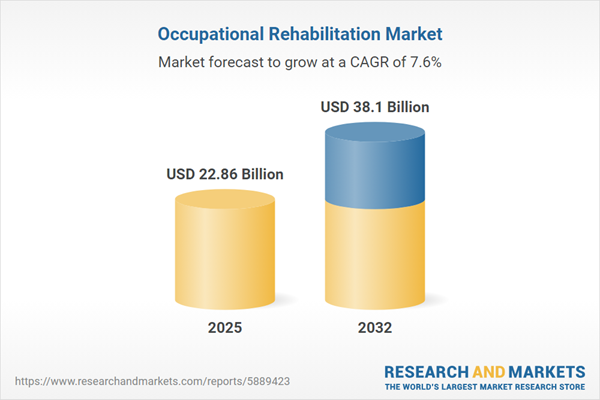Speak directly to the analyst to clarify any post sales queries you may have.
Occupational rehabilitation services are rapidly adapting to advances in technology, regulatory evolution, and shifting client expectations, providing critical support that enables workforces to recover, adapt, and perform in an increasingly complex healthcare and corporate environment.
Market Snapshot: Occupational Rehabilitation Market Overview
The occupational rehabilitation market grew from USD 21.27 billion in 2024 to USD 22.86 billion in 2025 and is set to expand at a CAGR of 7.56%, projected to reach USD 38.10 billion by 2032. Growth in this market is propelled by the intersection of advanced technologies, global regulatory shifts, and rising employer demand for comprehensive workplace health solutions. Senior decision-makers across healthcare and corporate sectors are focusing on scalable, outcome-oriented rehabilitation strategies to meet workforce needs while navigating cost and operational complexities.
Scope & Segmentation of the Occupational Rehabilitation Market
This report examines the occupational rehabilitation market through a granular lens, providing detailed analysis of service segments, delivery modes, end users, injury categories, referral sources, and regional trends. The segmentation clarifies avenues for innovation and highlights strategic priorities for organizations and investors alike.
- Service Types: Assistive technology (adaptive equipment, communication devices, mobility devices), case management (coordination services, medical management), ergonomic assessment (onsite assessment, workstation modification), physical therapy (electrotherapy, exercise therapy, manual therapy), and vocational rehabilitation (assessment, job placement, training)
- Delivery Modes: Inpatient, onsite (home, workplace), outpatient, telehealth (phone consultation, virtual video)
- End Users: Clinics, corporate employers, private and public hospitals, insurance providers, inpatient rehab centers, outpatient rehab centers
- Injury Types: Musculoskeletal (back injuries, lower limb injuries, upper limb injuries), neurological, occupational disease, psychological
- Referral Sources: Employers, government agencies, individuals, insurance companies (private insurers, workers' compensation boards)
- Regions: Americas (including North America and Latin America), Europe, Middle East & Africa, Asia-Pacific
- Leading Companies: UnitedHealth Group Incorporated, Select Medical Holdings Corporation, Encompass Health Corporation, CorVel Corporation, Hanger, Inc., Amedisys, Inc., Therapy Partners Holdings, U.S. Physical Therapy, ATI PT Holdings
Key Takeaways for Senior Decision-Makers
- Growth across occupational rehabilitation hinges on integrating digital health tools, such as remote assessments and data analytics, streamlining both outcomes and operational workflows.
- Employers now proactively seek ergonomic assessments, telehealth options, and preventive programs to minimize injury and maximize productivity, reflecting a strategic shift in workforce health management.
- Shifting regulatory environments and evolving insurance models are redirecting incentives toward outcome-based rehabilitation services, intensifying competition on care quality rather than volume.
- Collaboration among technology providers, clinicians, and corporate stakeholders is critical for delivering flexible, patient-centric services that align with diverse workplace and regulatory needs.
- Expanding regional alliances and innovative manufacturing partnerships enhance the resilience of supply chains and foster timely adoption of advanced assistive and adaptive technologies.
Tariff Impact Analysis
Recent U.S. tariff policies on imported assistive and rehabilitation equipment have increased procurement costs and complicated logistics, especially for adaptive and mobility devices. This shift has highlighted the importance of diversified supplier networks and spurred discussions about domestic production strategies. Organizations with established regional manufacturing or integrated procurement models have demonstrated operational agility, while smaller providers face greater disruption. These developments reinforce the strategic value of robust sourcing partnerships and flexible supply chain planning in the face of international trade fluctuations.
Methodology & Data Sources
The research adopts a multi-layered methodology including extensive reviews of peer-reviewed journals, regulatory reports, and industry white papers. Quantitative data is gathered from primary surveys, stakeholder interviews, and validated clinical registries. Advanced statistical analysis and thematic expert reviews ensure credibility, while triangulation of primary and secondary data supports robust insights tailored for B2B applications.
Why This Report Matters for Decision-Makers
- Identifies immediate and long-term opportunities for investment, resource allocation, and strategic partnerships in occupational rehabilitation.
- Clarifies complex market dynamics shaped by technological innovation and regulatory shifts, supporting targeted decision-making for sustained growth.
- Enables benchmarking against leading competitors and informs strategy development across regions, service lines, and user segments.
Conclusion
Occupational rehabilitation is evolving through innovation, collaborative ecosystems, and data-driven strategy. Stakeholders who adapt quickly will optimize workforce recovery and secure competitive advantage in a dynamic global market.
Additional Product Information:
- Purchase of this report includes 1 year online access with quarterly updates.
- This report can be updated on request. Please contact our Customer Experience team using the Ask a Question widget on our website.
Table of Contents
3. Executive Summary
4. Market Overview
7. Cumulative Impact of Artificial Intelligence 2025
Companies Mentioned
The companies profiled in this Occupational Rehabilitation market report include:- UnitedHealth Group Incorporated
- Select Medical Holdings Corporation
- Encompass Health Corporation
- CorVel Corporation
- Hanger, Inc.
- Amedisys, Inc.
- Therapy Partners Holdings, Inc.
- U.S. Physical Therapy, Inc.
- ATI PT Holdings, Inc.
Table Information
| Report Attribute | Details |
|---|---|
| No. of Pages | 188 |
| Published | October 2025 |
| Forecast Period | 2025 - 2032 |
| Estimated Market Value ( USD | $ 22.86 Billion |
| Forecasted Market Value ( USD | $ 38.1 Billion |
| Compound Annual Growth Rate | 7.5% |
| Regions Covered | Global |
| No. of Companies Mentioned | 10 |









